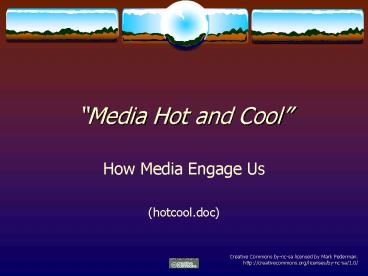Media Hot and Cool PowerPoint PPT Presentation
1 / 23
Title: Media Hot and Cool
1
Media Hot and Cool
- How Media Engage Us
- (hotcool.doc)
2
McLuhan Says
- A hot medium is one that extends one single
sense in high definition. High definition is
the state of being well filled with data. - Understanding Media, p. 22
Hot media are, therefore, low in participation,
and cool media are high in participation or
completion by the audience. Understanding Media,
p. 23
3
Hot Medium
Cool Medium
- Single sense, high defn, lots of information
- Little completion or active participation
- Tends to exclude
- Leads to specialization, fragmentation
- Numbs awareness, lessens total perception
- Short, intense experiences
- Tends to hijack attention
- Multiple senses, low defn, less info for each
- High participation, active completion
- Tends to include
- Leads to generalization, consolidation
- Engages awareness, heightens perception
- Longer, sustained experiences
- Actively aware attention
4
Examples
HOT
COOL
- Renaissance painting
Mosaic or abstract art
Photograph
Cartoon
Lecture
Seminar
Print (e.g. books)
Speech
Pop music
Contemporary jazz
5
(No Transcript)
6
McLuhan Says
Abstract art is the art of making the image, not
the art of matching inner and outer. Culture is
Our Business, p. 88
Abstract art is the art of making the image, not
the art of matching inner and outer. Culture is
Our Business, p. 88
- Abstract art is the art of making the image, not
the art of matching inner and outer. - Culture is Our Business, p. 88
7
McLuhan Says
- Consistency is a meaningless term to apply to an
explorer. If he wanted to be consistent, he would
say home. - McLuhan Hot Cool, p. xiii
8
McLuhan Says
- Dont allow my terminology to put you off. I
use language as a probe not a package. Even when
I seem to be making very dogmatic statements, I
am exploring contours. - Letter to Jonathan Miller, May 4, 1965
- Gordon, Escape Into Understanding, p. 214
9
Group Probes
- Why would a supermarket want to have an in-store
bakery and offer free samples? - Think of womens fashion. Is haut couture hot,
cool, both or neither?
10
The Effect-ive Artist
- The artist asks What precise effect do I want
to have on my public? What precise emotion do I
wish to evoke and define? The artists starts with
the effect, since the means to such an effect are
everywhere. - Take Today The Executive as Dropout, p. 99
11
The Artists Awareness
- The artist is the man in any field, scientific
or humanistic, who grasps the implications of his
actions and of new knowledge in his own time. He
is the man of integral awareness. - Understanding Media, p. 65
12
We Now Pause for aMessagefrom Our
SponsorSpawn Sir?Spinster?
13
(No Transcript)
14
(No Transcript)
15
(No Transcript)
16
(No Transcript)
17
(No Transcript)
18
(No Transcript)
19
Some Cool Stuff
- Lander
- Hyundai
- Levis
- Underdaks
- Volkswagen
- Toyota
- Woodpecker
- Racism Stop It!
- Japp 1
- Japp 2
- Japp 3
- Exam
- Apple Big Brother
- Movement Without Constraint
- Trash Mirror
- Starry, starry night
20
Television or Teletouch?
Television
- The TV image is now a mosaic mesh of light and
dark spots - The TV image requires each instant that we
close the spaces in the mesh by a convulsive
sensuous participation that is profoundly kinetic
and tactile - The TV image is one of low definition, in the
sense that it offers little detail and a low
degree of information - Understanding Media, Chapter 31
Hot or Cool?
21
The Moving Finger of Television
- But TV is, above all, an extension of the sense
of touch iconographic art uses the eye as we
use our hand The TV image even more than the
icon, is an extension of the sense of touch. - Understanding Media, 333 334
- The Moving Finger writes and, having
writ,Moves on nor all your Piety nor WitShall
lure it back to cancel half a Line,Nor all your
Tears wash out a Word of it - Edward Fitzgerald, The Rubaiyat of Omar Khayyam
22
Small Groups Probe
- What temperature is television now?
23
McLuhan Says
- Radio is a hot medium Radio will serve as
background-sound or as noise level control, as
when the ingenious teenager employs it as a means
of privacy. - Understanding Media, p. 312
24
McLuhan Says
- Put hundreds of extra lines on the TV image,
step up its visual intensity to a new hot level.
This might serve to reverse the whole effect of
TV. It might make the TV image photographic,
slick, like movies hot and detached. - McLuhan Hot Cool, p. 278
25
McLuhan Says
- Intensity or high definition engenders
specialism and fragmentation in living which
explains why any intense experience must be
reduced to a very cool state before it can be
assimilated. - For many people, this cooling system brings on a
life-long state of psychic rigor mortis, or of
somnambulism - Understanding Media, p. 24
26
Group Probes
- What affects the temperature of a medium?
- What causes media temperature to change?
27
Small Groups Probe II
- The hotting-up of one sense tends to effect
hypnosis, and the cooling of all senses tends to
result in hallucination. - Understanding Media, p. 32
- Overheating a medium induces reversal.
- Find examples and evidence of media that have
reversed temperatures. - Describe the situation, the ground and the
heating or cooling influences and effects.
28
For Next Time
- Modes of Conversation
- What are the effects of the various media of
conversation? - Are there analogues between the various types of
non-electronic and electronic media of
conversation? - Can we understand the often surprising effects of
electronically mediated communications?

